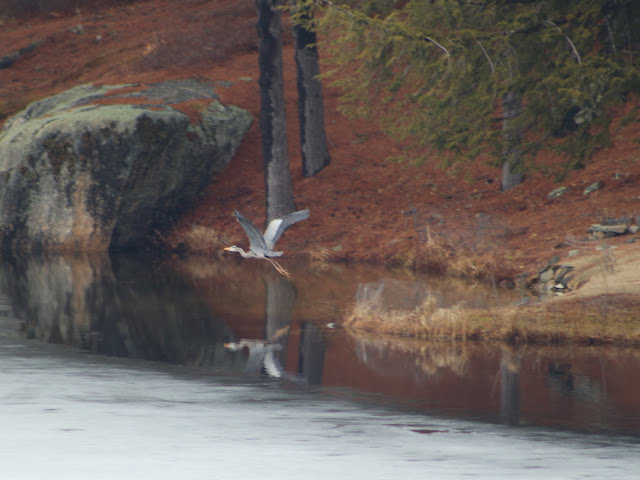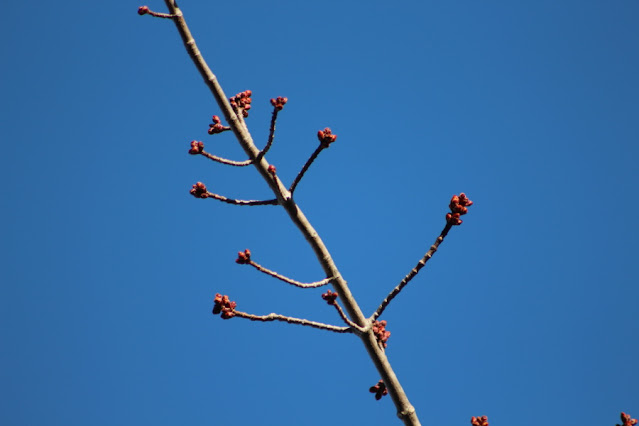We spent the past week a thousand miles south of the Lakes Region, getting an early peek at summer, and it sure was nice. We saw spring unfold before our eyes as we drove the scenic route to South Carolina through the Shenandoah Valley, watching bare branches turn to flowering trees, then budding leaves, and finally to blooming magnolias as we arrived in Charleston and Mount Pleasant. Our favorite Low-County tour guide had plenty of activities lined up for our entertainment, and one of the first was a visit to "Breach Inlet", a break in the barrier islands that separates Sullivan's Island from the Isle of Palms. We walked the Atlantic shore along Isle of Palms and when we reached The Breach we found a dolphin fishing right in the breach as the tide rushed out.
 |
| A bottlenosed dolphin. |
The breach is narrow so the current is swift as the water drains from the inland waterway when the tide goes out. There are docks and boats close by on either side, but the dolphin didn't seem to mind.
 |
| Looking for fish in the riptide. |
It swam against the strong current yet it remained stationary, diving down and coming up in the same spot, probably catching fish after fish coming out with the tide.
 |
| Swimming against the tide. |
It was one of the highlights of the trip.
Another wildlife spectacle was found at the edge of a small lake which contained an egret rookery.
These beautiful birds don't seem to mind sharing nesting territory as there are over a dozen nests in the same small area. And these birds are stunning when they show off all their plumage.
 |
| They have such an interesting shade of green on their face. |
They also seem to be magnanimous, allowing interlopers to share the neighborhood.
 |
| A male anhinga preens while his mate feeds the young in the nest. |
 |
| Mom with the hungry chicks. |
 |
| Feeding time at the anhinga home. |
The anhinga pair was ahead of the egrets in the nesting cycle as they already had four good-size chicks in the nest while there was no evidence of egret chicks.
Did I mention the large, smiling alligator hiding in the foliage on the edge of the pond, just waiting for one of those plump birds to make a mistake?
At another site, a marshy bay beside the Pitt Street Bridge in Charleston Harbor, we saw a wide range of birds, including sandpipers, brown thrashers, marsh wrens, grackles, and more egrets. I was able to watch one egret picking out its lunch from the marsh - probably small fish or shrimp.
Of course there were pelicans all around the South Carolina shore.
It's good to see pelicans making a comeback after their population was decimated by poisoning from pesticides.
We saw many animals that also live in New England, including ospreys.
 |
| Osprey over Isle of Palms |
Other northern birds we saw included cardinals, mockingbirds, bluebirds, sandpipers, wood ducks (already with chicks hatched) and of course, Carolina wrens. Yes, the Carolina wren has worked its way north even to New Hampshire as things have warmed up over the years.
All along the drive both down and back there was a nearly constant circling of vultures taking advantage of thermals over the highway to search for road kill. From a distance I can't tell the difference between turkey vultures, which migrate to New England in summer, and black vultures, which don't come as far north as New England. But up close the black face (versus red on the turkey vulture) is evident. The South Carolina vultures are more much more tame than they are here in New Hampshire.
 |
| A Black Vulture perches on a roof top and watches the world pass by. |
Alas, we did eventually have to return home. As we drove back to New England we watched the season retreat, eventually regressing all the way back to brown leaves and bare branches here in New Hampshire. But I was happy to see the see that the Trailing Arbutus are still blooming.
So we didn't miss much, and now we get to experience spring twice in the same year. Thanks for a great visit LG!












































